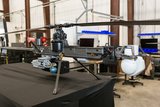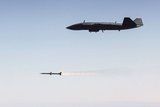US seeing implications of UAS roadmap
In accordance with the ‘US Army Roadmap for UAS 2010-2035’, the weaponising and ‘humanising’ of unmanned systems is 'no longer something of the future', according to a military official.
Speaking at the Defence IQ Military Robotics conference in London on 28 June, George Gonsalves, aviation systems analyst for unmanned aircraft for the US Army Capabilities Center, outlined the current trends and pressures the army has come across in implementing the roadmap.
He said that although autonomy is a hot topic for unmanned platforms, these systems are currently only 'enablers', and are not yet replacing soldiers.
'We're facing many challenges. We have not really seen many [systems] replacing the force structure yet but we are feeling the pressures to do so,' Gonsalves commented.
'Robotics exist to enable human activity. There's a lot of pressure for structure change. It doesn't do us any good to have billions of dollars worth of aircraft and sensors in the air if we can't get that data down to the point of the spirit that we're fighting on the ground.'
The emphasis at present is on procuring truly autonomous systems; however these do not come without implications, Gonsalves explained. There needs to be a seamless integration for the systems, they need to be trusted, and they need to be able to 'adapt to varying social cues and context'.
Although ‘humanising’ these platforms is advantageous, humans 'must be able to exert full control' over them, as an ethical issue arises with certain systems having the ability to kill.
While the roadmap outlines unmanned development for the US Army until 2035, Gonsalves warned that if it is not invested in now 'you'll never reach the end of the road map'.
The aim of the strategy between 2026 and 2035 is for the army to have an integrated system of systems, with universal commonality. However there is currently an 'unwillingness to reduce force structure'.
The army has 93 Shadow UAS platforms, but it aims to own 102. Each combat team has one, and the army is 'rewinging those Shadows' so they have a nine hour endurance, up from the four they currently have.
While the Wasp, Raven and Puma airborne platforms are also important systems for the army, Gonsalves revealed that it is struggling to develop a specific control system for ground robotics as the emphasis is on UAS. The army has developed its Unmanned Ground Systems Roadmap in response to this capability gap.
'Ground robotics, they're not as mature as unmanned aircraft systems right now. We only have one programme to record, and that's the SUG-V [Small Unmanned Ground Vehicle].'
He said there is 'friction right now' amidst pressure to support these systems, but it is 'realistic' that UGVs will be weaponised by the latter end of the roadmap.
Another pressure on the army is to introduce more VTOL platforms as they do not require a runway, although this comes at an extra cost.
More from Uncrewed Vehicles
-
![What's next for the Pentagon after the Replicator programme?]()
What's next for the Pentagon after the Replicator programme?
Although the Replicator initiative has made several accomplishments, there are still multiple gaps to plug across the US Department of Defense (DoD) and its services.
-
![Cummings Aerospace showcases Hellhound loitering munition designed for US Army’s LASSO programme (video)]()
Cummings Aerospace showcases Hellhound loitering munition designed for US Army’s LASSO programme (video)
Cummings Aerospace presented its turbojet-powered Hellhound loitering munition at SOF Week 2025, offering a man-portable solution aligned with the US Army’s LASSO requirements.
-
![SOF Week 2025: PDW unveils attritable FPV drone for SOF operations at scale]()
SOF Week 2025: PDW unveils attritable FPV drone for SOF operations at scale
PDW has revealed its Attritable Multirotor First Person View drone at SOF Week 2025, offering special operations forces a low-cost, rapidly deployable platform for strike and ISR missions, inspired by battlefield lessons from Ukraine.
-
![SOF Week 2025: Teledyne FLIR white paper provides guidance on reusable loitering munitions]()
SOF Week 2025: Teledyne FLIR white paper provides guidance on reusable loitering munitions
Teledyne FLIR is highlighting the emerging requirements for 'recoverable and re-usable' loitering munitions across the contemporary operating environment during this week’s SOF Week conference in Tampa, Florida.
-
![SOF Week 2025: Kraken Technology group debuts K3 Scout USV in North America]()
SOF Week 2025: Kraken Technology group debuts K3 Scout USV in North America
High-performance maritime industry player Kraken Technology Group, based in the UK, has used the SOF Week conference in Tampa, Florida this week to debut its K3 Scout uncrewed surface vessel (USV) to the North American market.
-
![Palladyne AI and Red Cat to demonstrate capabilities for autonomous drone swarms to the US military]()
Palladyne AI and Red Cat to demonstrate capabilities for autonomous drone swarms to the US military
Red Cat and Palladyne AI recently conducted a cross-platform collaborative flight involving three diverse heterogeneous drones.

























